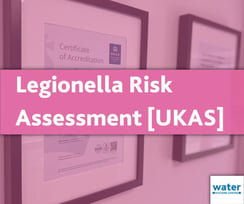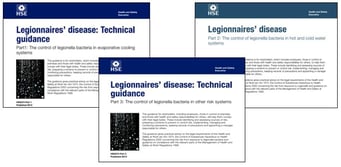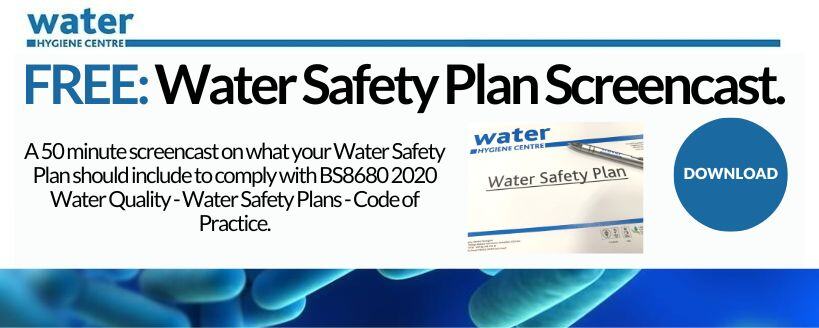Before we can discuss the uses and benefits of an independent water safety audit, it’s important to understand what one is and what it entails. An independent water safety audit completed by an Authorising Engineer (Water) is not to be feared but to be welcomed as a measure to promote compliance within an organisation.
Whether water systems are being managed within a healthcare setting or non-healthcare setting, there are legal (absolute) requirements detailed within health and safety law which underpin our approach to safe water management.
Water Safety Guidance
Guidance is available in the form of BS 8680:2020 Water quality. Water safety plans. Code of practice, which will aid you in developing and implementing a written control scheme or ‘water safety plan’ and demonstrating an ongoing review of the scheme to ensure it remains effective and relevant. An annual independent audit is one such method of review. Moreover, we must first understand and invest in our written scheme of control to understand how an independent audit is structured and delivered.
We can section the written scheme of control or 'water safety plan' into four core areas:
- Water Management Policy
- Legionella Risk Assessment & Schematics
- Operational Procedures
- Legionella Log books or Water Safety Records (reporting and recording evidence)
We will look at auditing each of these four areas in more detail below.
Water Management Policy
Therefore, the annual audit will typically start with a review of the water management policy. It makes sense to first understand the management strategy and arrangements that underpin the organisational processes for the safe management of water systems.
As a rule, if concerns arise relating to compliance, then it’s prudent to revisit the supporting processes. Conversely, should an organisation not have confidence in their policy and process because it’s demonstrably flawed then it’s unreasonable to expect an improvement in compliance. Following a review of this area of compliance, the water safety audit may be used to:
- Highlight inaccuracies within the management structure of an organisation, such as the need to formally capture roles and responsibilities within the organisational water safety policy, as well as to formally appoint persons with a water management responsibility in writing; especially the Responsible Person (RP) for water.
- Identify Legionella training requirements for all persons with responsibility for the safety of the water systems – delineating between management and operational responsibilities.
 Identify the requirement for further measures of competency such as the completion of suitable appraisals by the Authorising Engineer (Water), of the Responsible Person, and the Authorised Persons. Such appraisals typically look for evidence of qualifications, experience, and knowledge appropriate to the site, role & responsibilities, and applicable legislation and guidance. Organisations should ensure that competency appraisals are completed for all persons with a water management responsibility.
Identify the requirement for further measures of competency such as the completion of suitable appraisals by the Authorising Engineer (Water), of the Responsible Person, and the Authorised Persons. Such appraisals typically look for evidence of qualifications, experience, and knowledge appropriate to the site, role & responsibilities, and applicable legislation and guidance. Organisations should ensure that competency appraisals are completed for all persons with a water management responsibility.- Assess an organisation’s ‘attitude’ towards water safety and whether a pragmatic or reactive approach has been adopted to protect staff, occupiers, service users, and others from harmful waterborne contaminants such as Pseudomonas aeruginosa and Legionella. A pragmatic approach to water management may be evidenced by the formation of a water safety group or in the way that an organisation manages risk once it’s been highlighted.
Legionella Risk Assessments & Schematics
The completion of site-specific legionella risk assessments is another ‘absolute requirement’ under health and safety law and should be completed to current standards.
Moreover, the water safety audit will identify whether assessments have been completed following the requirements of the HSE’s ACOP L8 and British Standard 8580-1 2019 Water Quality, Risk Assessment for Legionella control, and whether the process was UKAS accredited and completed by a competent Legionella Risk Assessor.
 Quality Risk assessment providers should also be able to demonstrate up-to-date professional membership/registration to relevant bodies (e.g. Legionella Control Association, UKAS). The quality of the risk assessment is of paramount importance as the information contained within it will inform the control scheme and action plans and shape how water safety is managed.
Quality Risk assessment providers should also be able to demonstrate up-to-date professional membership/registration to relevant bodies (e.g. Legionella Control Association, UKAS). The quality of the risk assessment is of paramount importance as the information contained within it will inform the control scheme and action plans and shape how water safety is managed.
If the water safety audit identifies irregularities or doubts over the accuracy of the risk assessments or the associated schematic drawings, then this could undermine confidence in the control regime. If potential shortfalls are identified within the assessment, consideration should be given to reviewing the current assessment, or better still, carrying out a new assessment in line with current guidance to give assurance that the assessment and resultant recommendations and control regime derived from it are suitable and sufficient to manage or mitigate any risk as far as is reasonably practicable.
If we can demonstrate and accept that legionella risk assessments & schematics have been completed with accuracy and to the desired standard, then we can review recommendations that have been made and devise an action plan that supports a ‘proportionate’ approach to risk management. That isn’t to say that we simply accept certain risks as derogations, but we must adopt a measured approach to managing risk. This means an approach that is underpinned by the principle of ‘as low as reasonably practicable’ and that action priorities are calculated based on the associated risk, cost, and difficulty – which the annual audit supports.
Moreover, if our approach is to be truly measured we must acknowledge the difference between inherent and residual risk, whilst evidencing the rationale for adopting either conventional, good, or best practice. In short, service users and their vulnerability always need to be considered as this will inevitably determine when conventional, good, or best practice are suitable. For example, only ‘best practice’ would be considered suitable for managing areas occupied by high-risk patient groups.
Operational Procedures
Moving on to ‘operational procedures’, the annual audit will also appraise ‘control strategy’ using the concept of monitoring to establish control and Legionella sampling for a particular reason. The traditional primary method of control is temperature for the good reason that if cold water remains cold (<20˚C) and hot water is kept hot (50˚C to 60˚C) throughout the system then it is unusual to have an issue with waterborne bacteria.
 The guidance in HSG 274 Parts 1, 2 and 3 details how to safely manage water systems, with Part 2 focusing on the management of hot and cold-water systems and identifying suitable monitoring frequencies. Careful application of this guidance can ensure that such waters do not become a reservoir for bacterial contamination. The audit will examine compliance with these monitoring frequencies, and it will also interrogate and appraise other precautions taken to minimise the growth of waterborne contaminants, such as:
The guidance in HSG 274 Parts 1, 2 and 3 details how to safely manage water systems, with Part 2 focusing on the management of hot and cold-water systems and identifying suitable monitoring frequencies. Careful application of this guidance can ensure that such waters do not become a reservoir for bacterial contamination. The audit will examine compliance with these monitoring frequencies, and it will also interrogate and appraise other precautions taken to minimise the growth of waterborne contaminants, such as:
- Procedures to ensure the normal daily use of all outlets and for flushing programmes where outlets are found to be infrequently used;
- The identification and possible removal of flexible hoses;
- The completion of scald risk assessment to substantiate the number of TMVs in situ etc.
- Any supplementary control strategies used (e.g. chemical dosing systems).
In addition, the audit will review microbiological sampling practices to ensure that; the sampling strategy is supported by the legionella risk assessment (i.e. sampling for a particular reason) and that samples are taken following the approved technique with a chain of custody that ensures samples are processed by a UKAS accredited laboratory and remain within the required stability parameters (i.e. samples are representative of the system sampled). BS7592-2022. Sampling for Legionella bacteria in water systems code of practice details this protocol.
Legionella Logbooks
The annual audit will typically conclude with a review of how all this data is recorded. The suitability of the records management system will be defined by the completeness and accuracy of the data held on such systems at the time of audit.
Conclusion
The annual water safety audit is not a piece of work to be feared but it is an invaluable tool to identify and correct inaccuracies within management and operational strategy. The audit may be seen as a ‘strategic health check’ for estates/organisations providing a means of demonstrating compliance with water safety requirements and associated health and safety laws.
Feel free to reach out if you have any questions about the issues mentioned above or if you would like to consult with one of our experts on water hygiene.
Editors Note: The information provided in this blog is correct at the date of original publication – July 2019 (Revised March 2024).
© Water Hygiene Centre 2024








